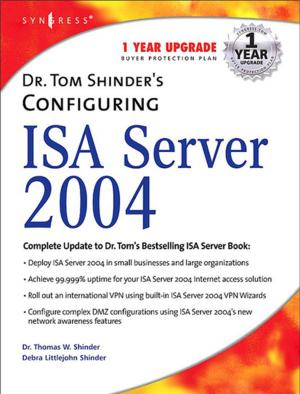Information Security Science
Measuring the Vulnerability to Data Compromises
Nonfiction, Computers, Networking & Communications, Computer Security, Operating Systems, Application Software| Author: | Carl Young | ISBN: | 9780128096468 |
| Publisher: | Elsevier Science | Publication: | June 23, 2016 |
| Imprint: | Syngress | Language: | English |
| Author: | Carl Young |
| ISBN: | 9780128096468 |
| Publisher: | Elsevier Science |
| Publication: | June 23, 2016 |
| Imprint: | Syngress |
| Language: | English |
Information Security Science: Measuring the Vulnerability to Data Compromises provides the scientific background and analytic techniques to understand and measure the risk associated with information security threats. This is not a traditional IT security book since it includes methods of information compromise that are not typically addressed in textbooks or journals.
In particular, it explores the physical nature of information security risk, and in so doing exposes subtle, yet revealing, connections between information security, physical security, information technology, and information theory. This book is also a practical risk management guide, as it explains the fundamental scientific principles that are directly relevant to information security, specifies a structured methodology to evaluate a host of threats and attack vectors, identifies unique metrics that point to root causes of technology risk, and enables estimates of the effectiveness of risk mitigation.
This book is the definitive reference for scientists and engineers with no background in security, and is ideal for security analysts and practitioners who lack scientific training. Importantly, it provides security professionals with the tools to prioritize information security controls and thereby develop cost-effective risk management strategies.
- Specifies the analytic and scientific methods necessary to estimate the vulnerability to information loss for a spectrum of threats and attack vectors
- Represents a unique treatment of the nexus between physical and information security that includes risk analyses of IT device emanations, visible information, audible information, physical information assets, and virtualized IT environments
- Identifies metrics that point to the root cause of information technology risk and thereby assist security professionals in developing risk management strategies
- Analyzes numerous threat scenarios and specifies countermeasures based on derived quantitative metrics
- Provides chapter introductions and end-of-chapter summaries to enhance the reader’s experience and facilitate an appreciation for key concepts
Information Security Science: Measuring the Vulnerability to Data Compromises provides the scientific background and analytic techniques to understand and measure the risk associated with information security threats. This is not a traditional IT security book since it includes methods of information compromise that are not typically addressed in textbooks or journals.
In particular, it explores the physical nature of information security risk, and in so doing exposes subtle, yet revealing, connections between information security, physical security, information technology, and information theory. This book is also a practical risk management guide, as it explains the fundamental scientific principles that are directly relevant to information security, specifies a structured methodology to evaluate a host of threats and attack vectors, identifies unique metrics that point to root causes of technology risk, and enables estimates of the effectiveness of risk mitigation.
This book is the definitive reference for scientists and engineers with no background in security, and is ideal for security analysts and practitioners who lack scientific training. Importantly, it provides security professionals with the tools to prioritize information security controls and thereby develop cost-effective risk management strategies.
- Specifies the analytic and scientific methods necessary to estimate the vulnerability to information loss for a spectrum of threats and attack vectors
- Represents a unique treatment of the nexus between physical and information security that includes risk analyses of IT device emanations, visible information, audible information, physical information assets, and virtualized IT environments
- Identifies metrics that point to the root cause of information technology risk and thereby assist security professionals in developing risk management strategies
- Analyzes numerous threat scenarios and specifies countermeasures based on derived quantitative metrics
- Provides chapter introductions and end-of-chapter summaries to enhance the reader’s experience and facilitate an appreciation for key concepts















